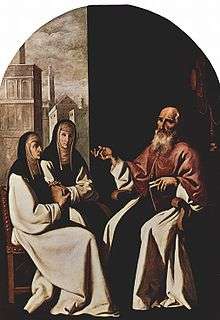Eustochium
Saint Eustochium (c. 368 – September 28, 419 or 420). Born Eustochium Julia at Rome, she was the daughter of Paula and is also venerated as a saint and was an early Desert Mother. She was the third of four daughters of the Roman Senator Toxotius, for whom Jerome made a lot of fanciful claims of ancestry.[1] After the death of her husband around 380 Paula and her daughter Eustochium lived in Rome as austere a life as the fathers of the desert. Eustochium had three sisters, Blaesilla, Paulina, and Rufina, and a brother, Toxotius.[2]
Saint Eustochium | |
|---|---|
 Saint Jerome, Saint Paula, and Saint Eustochium, at National Gallery of Art in Washington. | |
| Born | c. 368 Rome |
| Died | c. 419 or 420 Bethlehem |
| Venerated in | Roman Catholic Church Eastern Orthodox Church Eastern Catholic Churches |
| Feast | 28 September |
When Jerome came to Rome from Palestine in 382, they put themselves under his spiritual guidance. Hymettius, an uncle of Eustochium, and his wife Praetextata tried to persuade the youthful Eustochium to give up her austere life and enjoy the pleasures of the world, but all their attempts were futile. About the year 384 she made a vow of perpetual virginity, on which occasion Jerome addressed to her his celebrated letter De custodia virginitatis (Ep. xxii in P.L., XXII, 394–425). A year later Jerome returned to Palestine and soon after was followed to the Orient by Paula and Eustochium.[2]
In 386 they accompanied Jerome on his journey to Egypt, where they visited the hermits of the Nitrian Desert in order to study and afterward imitate their mode of life. In the fall of the same year they returned to Palestine and settled permanently at Bethlehem. Paula and Eustochium at once began to erect four monasteries and a hospice near the spot where Christ was born. While the erection of the monasteries was in process (386–9) they lived in a small building in the neighbourhood. One of the monasteries was occupied by monks and put under the direction of Jerome. The three other monasteries were taken by Paula and Eustochium and the numerous virgins that flocked around them. The three convents, which were under the supervision of Paula, had only one oratory, where all the virgins met several times daily for prayer and the liturgy of the hours. Jerome testifies (Ep. 308) that Eustochium and Paula performed the most menial services. Much of their time they spent in the study of Holy Scripture under the direction of Jerome.
Eustochium spoke Latin and Classical Greek with equal ease and was able to read the scriptures in the Hebrew text. Many of Jerome's Biblical commentaries owe their existence to her influence and to her he dedicated his commentaries on the prophets Isaias and Ezekiel.
The letters which Jerome wrote for her instruction and spiritual advancement are, according to his own testimony,[3] very numerous. After the death of Paula in 404, Eustochium assumed the direction of the nunneries.[2] Her task was a difficult one on account of the impoverished condition of the temporal affairs which was brought about by the lavish almsgiving of Paula. Jerome was of great assistance to her by his encouragement and prudent advice.
In 417, a crowd of ruffians attacked and pillaged the monasteries of Bethlehem, destroyed one of them by fire, besides killing and maltreating some of the residents. It is alleged[4] that this was instigated by John II, the Patriarch of Jerusalem and the Pelagians against whom Jerome had written what were considered sharp polemics. Both Jerome and Eustochium informed Pope Innocent I by letter of the occurrence, who severely reproved the patriarch for having permitted the outrage. Eustochium died shortly after and was succeeded in the supervision of the convents by her niece, the younger Paula. Eustochius of Tour might have been her nephew, and further lateral descendants may include Perpetuus and Volusianus.[5] The Church celebrates her feast on 28 September.
References
- According to Jerome, Toxotius was believed to belong to the noble Julian race, while St. Paula traced her ancestry through the Scipios and the Gracchi (Jerome, Epistle cxviii). Modern genealogists don't buy into these claims.
- "Saints Paula and Eustochium", Christian Iconography
- De Viris Illustribus, cap. cxxxv.
-

- T. S. M. Mommaerts & D. H. Kelley, The Anicii of Gaul and Rome, in Fifth-century Gaul: a Crisis of Identity?, ed. by John Drinkwater and Hugh Elton, (Cambridge University Press, Cambridge & New York, 1992) 120–121.
![]()
External links
- S. Eusebii Hyeronimy Stridonesis Presbyteri (1845). "Commentarius in Ecclesiasten". Sancti Eusebii Hieronymi ... opera omnia, studio et labore Vallarsii et Maffæii (Volumes 2 and 3) (in Latin). Paris: Vallarsi and Maffaei (presbyteries). pp. vi, 1009. (with the contribution of J. P. Migne)